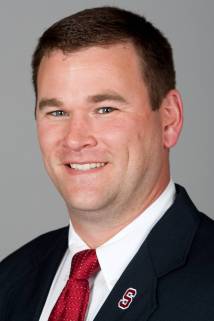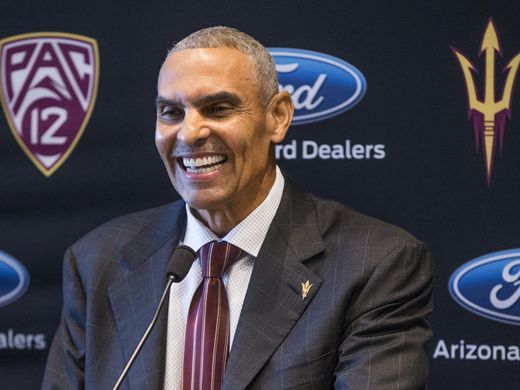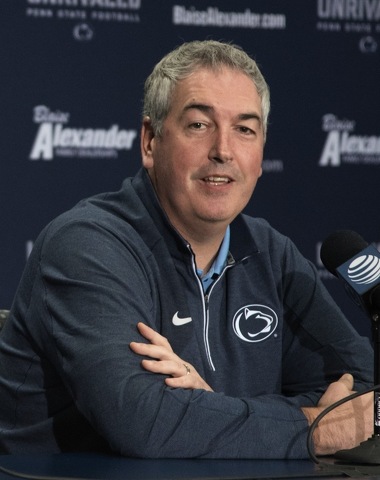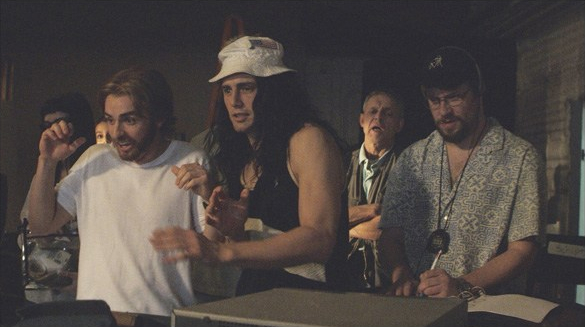#21 — Sean Lewis, Kent State
- Age: 32
- Hometown: Oak Lawn, Illinois
- Alma Mater: Wisconsin
- Previous Job: Co-Offensive Coordinator/Quarterbacks Coach, Syracuse
This is one of the toughest jobs in the nation, and Paul Haynes, a Kent State alum, still faced a mountain of obstacles, going 14-45 in five years and never winning more than four games in a season.
Lewis has been with Syracuse head coach Dino Babers since 2012, following him from Eastern Illinois to Bowling Green to Syracuse, smashing offensive records along the way. He’s an energetic guy who knows offense as well as anybody, but this job is not your average one. Lewis needs plenty of time to clean up this mess.
#20 — Dana Dimel, UTEP
- Age: 55
- Hometown: Columbus, Ohio
- Alma Mater: Kansas State
- Previous Job: Offensive Coordinator/Running Backs Coach/Tight Ends Coach, Kansas State
It can’t get any worse in El Paso — UTEP is coming off a winless 2017 campaign, so new AD Jim Senter decided to look outside the box for his first major hire. The 55-year-old Dimel is a proven assistant from the venerable Bill Snyder coaching tree, but his track record as a coach is mixed: he did reasonably well at Wyoming from 1997-99, but then crashed and burned at Houston (2000-02) before returning to K-State. He’s a good recruiter and should give the UTEP offense a much-needed shot in the arm, but his long-term success is harder to predict.

#19 — Steve Campbell, South Alabama
- Age: 51
- Hometown: Pensacola, Florida
- Alma Mater: Troy
- Previous Job: Head Coach, Central Arkansas
Campbell was an intriguing choice for this position. An Alabama native and a Troy alum, the 51-year-old Campbell won 33 games in the past four years at FCS Central Arkansas, and also has experience at the Division II level and the junior college level in Mississippi.
The Jaguars showed flashes of great potential and sprang several notable upsets under longtime coach Joey Jones, but never quite turned the corner, going 29-46 overall since joining the Sun Belt in 2012. Campbell will feel right at home in Mobile, as he tries to take a South Alabama program to new heights.

#18 — Mike Bloomgren, Rice
- Age: 40
- Hometown: Tallahassee, Florida
- Alma Mater: Florida State
- Previous Job: Offensive Coordinator/Offensive Line Coach, Stanford
After a 1-11 season, things currently look as bleak at Rice as they have in some time, but Bloomgren could end up being a nice sleeper pick. The former Stanford offensive coordinator brings a no frills, run-first offense that prioritizes being disciplined and mentally tough, and it helps that he has experience recruiting at a program with high academic standards. Give him a couple years and the Owls could be consistently competitive again.
#17 — Chad Lunsford, Georgia Southern
- Age: 40
- Hometown: Elberton, Georgia
- Alma Mater: Georgia College
- Previous Job: Tight Ends Coach/Special Teams Coordinator, Georgia Southern
A school birthed in the triple-option tradition, Georgia Southern hit rock-bottom in 2017, firing Tyson Summers after an 0-6 start and then going 2-4 with Lunsford as the interim head coach. Despite looking at flashier candidates, Georgia Southern elected to reward Lunsford, the school’s longest-tenured assistant (in addition to Summers, Lunsford served under former coaches Willie Fritz and Jeff Monken).
Lunsford is as enthusiastic as anyone, even if he is unproven as a full-time head coach himself. The Eagles have plenty of talent, but they never flourished under Summers, a defensive guru, and their offense sputtered without a clear identity. Getting back to the option is the first order of business, and Lunsford is committed to doing so. Whether that translates to a return to Sun Belt prominence remains to be seen.
#16 — Matt Luke, Ole Miss
- Age: 41
- Hometown: Gulfport, Mississippi
- Alma Mater: Ole Miss
- Previous Job: Co-Offensive Coordinator/Offensive Line Coach, Ole Miss
Considering the current circumstances in Oxford, the school was smart to promote from within. Luke was the 2017 interim coach and former offensive line coach under Hugh Freeze, as well as an alum who wants to be there. The NCAA is still hovering around the program and the Rebels will suffer through another bowl ban in 2018, but give credit to the 2017 squad for not quitting and rallying to reach .500. There’s still plenty of challenges ahead, but Luke seems ready to take them on, and he has some talent to work with.
#15 — Jonathan Smith, Oregon State
- Age: 38
- Hometown: Pasadena, California
- Alma Mater: Oregon State
- Previous Job: Co-Offensive Coordinator/Quarterbacks Coach, Washington
Gary Andersen’s abrupt departure after a 1-5 start in 2017 was surprising, as the Beavers had shown flashes of potential under his watch. However, they never settled on a quarterback, cycling through six in two and a half years, and also dealt with young and inexperienced defenses.
Meanwhile, Smith had significant success the past two years as co-offensive coordinator at Pac-12 North rival Washington and should definitely give the Beavers a shot in the arm. In addition to being an OSU alum, Smith has spent his entire coaching career elsewhere in the Pacific Northwest at Idaho (2004-09), Montana (2010-11), and Boise State (2012-13). He should be the right guy to navigate a tough job in Corvallis.

#14 — Mario Cristobal, Oregon
- Age: 47
- Hometown: Miami, Florida
- Alma Mater: Miami
- Previous Job: Co-Offensive Coordinator/Offensive Line Coach, Oregon
Willie Taggart never seemed to be an ideal fit in Eugene, but it was still surprising to see him bolt after only one season. The 2017 product was average, but the Ducks still have plenty of talent left over for Cristobal, the former offensive line coach who was promoted from within following UO’s long tradition.
The 47-year-old Cristobal is a great recruiter who also has head coaching experience at Florida International (2007-12), where he inherited a trainwreck of a program and made it reasonably competitive. He also has assistant coaching experience at programs from Alabama to Rutgers. The Ducks should be in good hands, although there’s little margin for error these days in the Pac-12 North.
#13 — Chad Morris, Arkansas
- Age: 49
- Hometown: Edgewood, Texas
- Alma Mater: Texas A&M
- Previous Job: Head Coach, SMU
Morris, one of the top offensive minds in the nation, engineered a turnaround at SMU the past three years, going from two wins to five to seven. He also has a sterling pedigree as both a Texas high school coach and as a former offensive coordinator at Clemson (2011-14).
The one red flag is the fact that Morris’s defenses were routinely dreadful at SMU. You can’t win many shootouts in the SEC. He’ll also need a couple of years to transition from Bret Bielema’s old-school, run-heavy offense to a more wide open spread scheme. He’ll get a reasonably long leash from new athletic director Hunter Yurachek.
#12 — Sonny Dykes, SMU
- Age: 48
- Hometown: Big Spring, Texas
- Alma Mater: Texas Tech
- Previous Job: Offensive Analyst, TCU
Post-death penalty SMU remains a tough place to win consistently, and give credit to Chad Morris for building an excellent foundation and upgrading the facilities before he bolted for Arkansas this past offseason. Dykes is hardly a fresh new face, and he didn’t do so well at Cal, but he never really seemed to be an ideal fit in Berkeley to begin with. Can the Mustangs take the next step forward and dethrone UCF and Memphis at the top of the conference? Dykes gives them as good a shot as anybody.

#11 — Herm Edwards, Arizona State
- Age: 63
- Hometown: Fort Monmouth, New Jersey
- Alma Mater: San Diego State
- Previous Job: ESPN analyst
Edwards came out of nowhere to become the leading contender for the vacant ASU job, landing the full-time gig on December 3rd. He takes over for Todd Graham, who started off with a bang when he took over in 2012, but peaked too early, going 18-19 in the past three years after a 28-12 mark in his first three seasons.
While Edwards’s disciplined approach and NFL experience will certainly be a draw for potential recruits, one has to wonder if the college game has passed him by — he hasn’t coached anywhere for a decade and hasn’t been in the college game since an assistant gig at San Jose State from 1987-89. Side note: both Edwards and athletic director Ray Anderson publicly stated that they wanted to hold on to both of Graham’s coordinators, Billy Napier and Phil Bennett, but they both left within a week, making the transition trickier. It might be a case of wait-and-see in Tempe.

#10 — Kevin Sumlin, Arizona
- Age: 53
- Hometown: Brewton, Alabama
- Alma Mater: Purdue
- Previous Job: Head Coach, Texas A&M
Sumlin inherits an Arizona program that has plenty of talent left over from former coach Rich Rodriguez, who was dismissed in the offseason was prompted by sexual harassment allegations. Can Sumlin win consistently while no longer under the albatross of high expectations at Texas A&M? He won big at Houston from 2008-2011, and has a well-deserved reputation as an elite recruiter, so he should fit in well in the wide-open Pac-12 South.
#9 — Josh Heupel, UCF
- Age: 39
- Hometown: Aberdeen, South Dakota
- Alma Mater: Oklahoma
- Previous Job: Offensive Coordinator/Quarterbacks Coach, Missouri
It was fairly obvious by season’s end that Scott Frost would be jumping to Nebraska (his alma mater) after orchestrating a perfect 13-0 regular season and a conference title in Orlando.
Heupel, the former Oklahoma QB and assistant, has spent the past two years at Missouri, where he helped transform Drew Lock into one of the SEC’s best passers. A proven recruiter, Heupel walks into a seemingly perfect situation at a program with on-field explosiveness, excellent facilities, a fantastic recruiting area, and a passionate fanbase. This could be an ideal fit.
#8 — Billy Napier, Louisiana-Lafayette
- Age: 37
- Hometown: Chatsworth, Georgia
- Alma Mater: Furman
- Previous Job: Offensive Coordinator/Quarterbacks Coach, Arizona State
UL-Lafayette regressed considerably in the past three years under Mark Hudspeth, and NCAA sanctions (which included vacated wins from 2011-14) didn’t help. With that being said, this hiring could be a slam-dunk for all involved. Napier is still young, and he’s cut his teeth at both Clemson and Alabama, earning a reputation as one of the nation’s best recruiters in the process. With the amount of talent in the state of Louisiana, Napier should be able to mine fertile recruiting regions in the immediate area and re-energize a fanbase that is as passionate as any in the Group of Five.
#7 — Joe Moorhead, Mississippi State
- Age: 44
- Hometown: Pittsburgh, Pennsylvania
- Alma Mater: Fordham
- Previous Job: Offensive Coordinator/Quarterbacks Coach, Penn State
Kudos to Dan Mullen for staying in Starkville and not jumping at the first opportunity; his nine years with the Bulldogs produced some memorable seasons and stats, and AD John Cohen was looking to keep the good times rolling when he hired Moorhead. The former Penn State offensive coordinator engineered a spectacular turnaround for them in the past two seasons, and before that, he led Fordham (his alma mater) to a 38-13 mark in four seasons (2012-15). Mississippi State should stay relevant.
#6 — Willie Taggart, Florida State
- Age: 41
- Hometown: Bradenton, Florida
- Alma Mater: Western Kentucky
- Previous Job: Head Coach, Oregon
This development came about after a dreadful 2017 season for the Seminoles and the subsequent bombshell departure of Jimbo Fisher to Texas A&M. Taggart is a terrific choice for this position, as a Florida native and a proven developer of talent. Plus, he never seemed to be an ideal fit in Eugene. The question is: can Taggart help FSU get back to consistently challenging Clemson for ACC titles?
#5 — Dan Mullen, Florida
- Age: 45
- Hometown: Drexel Hill, Pennsylvania
- Alma Mater: Ursinus
- Previous Job: Head Coach, Mississippi State
Mullen was one of the country’s most consistent winners at Mississippi State, bringing excitement and stability to a program that needed both when he took over prior to the 2009 season. The 45-year-old is a great recruiter and an even better offensive mind, with a long track record of developing quarterbacks. He’ll look to bring a shot in the arm to a Florida team that has been running on fumes since Urban Meyer left town.
Speaking of which — Mullen’s connections to UF as a former Meyer assistant is the primary reason he was brought in to right the ship in Gainesville. The only major areas of concern are the fact that, while Mississippi State enjoyed a historic run under Mullen (eight straight bowl trips), they rarely recorded major upsets or made national noise when it mattered. With that being said, this is a great hire that most Gator fans will buy into immediately.
#4 — Jeremy Pruitt, Tennessee
- Age: 43
- Hometown: Rainsville, Alabama
- Alma Mater: Alabama
- Previous Job: Defensive Coordinator, Alabama
This hellish offseason in Knoxville culminated with a 4-8 record on the field, Butch Jones’s midseason firing, a pouring of outrage when school administration attempted to bring in an alleged Penn State scandal conspirator (Greg Schiano), and then finally the promotion of Hall of Fame coaching legend Phil Fulmer to make the official decision in place of ousted AD John Currie.
Enter Pruitt, an outstanding defensive mind who has done exceptional work at Florida State, Georgia, and most recently Alabama. Before that, he had a long run at a number of different Alabama high schools and developed a well-deserved reputation as a players’ favorite. Tennessee is desperate for success, and with the 43-year-old Pruitt — a two-time Broyles Award finalist — they might finally have some stability.
#3 — Scott Frost, Nebraska
- Age: 42
- Hometown: Wood River, Nebraska
- Alma Mater: Nebraska
- Previous Job: Head Coach, UCF
It’s been a tough few years for Nebraska, dealing with porous defenses and an overall lack of consistency under veteran coach Mike Riley, who went 19-19 in the past three seasons.
Frost, a Nebraska alum, has a background as a Chip Kelly disciple and did an incredible job at UCF: he inherited an 0-12 team in 2015 and went 18-7 in two seasons, including an undefeated regular season mark in 2017. Frost will certainly add lots of excitement on offense and rejuvenate the fanbase, both of which are imperative heading forward. An outstanding hire.

#2 — Jimbo Fisher, Texas A&M
- Age: 52
- Hometown: Clarksburg, West Virginia
- Alma Mater: Samford
- Previous Job: Head Coach, Florida State
Well this will be interesting. Texas A&M administration has made it abundantly clear that they expect the Aggies to be perennial national title contenders — not an easy task in the SEC and one that consistently eluded Kevin Sumlin after his high watermark debut season in 2012.
Fisher was 83-23 during his tenure in Tallahassee, and a terrible 2017 season notwithstanding, carved out an impressive legacy in the post-Bobby Bowden era. Fisher is an excellent recruiter and should be able to get Sumlin’s players to buy in immediately, but there are questions about his staff, as many FSU fans grumbled that he held on to coordinators for too long and was too conservative of a playcaller. Regardless, this is a very good hire and one that should keep Aggie fans invested as the program looks to push higher.

#1 — Chip Kelly, UCLA
- Age: 54
- Hometown: Dover, New Hampshire
- Alma Mater: New Hampshire
- Previous Job: ESPN analyst
It was inevitable that Kelly was going to try to make a splash again in the college game. It was just a question of “when?” and “with who?”
Jim Mora was a veteran name and an excellent recruiter, but fell behind in the Pac-12 rat race and never recovered. Labeled as chronic underachievers who only received buzz due to NFL prospect Josh Rosen, UCLA finished badly in the past three seasons despite the obvious talent on the roster and numerous changes in scheme.
While Kelly’s NFL career didn’t pan out, he remains one of college football’s biggest innovators, and his hiring instantly makes UCLA one of the nation’s most intriguing teams. He’ll have a chance to work his magic in Westwood.






























